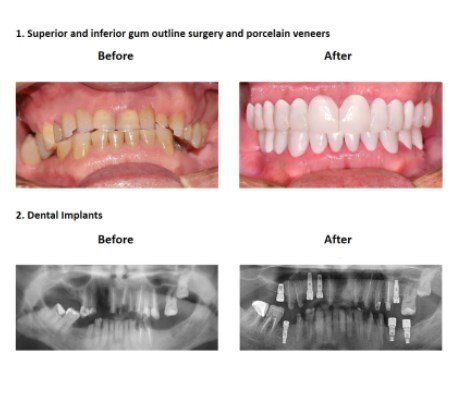Full mouth rehabilitation is very popular in advanced dentistry. It is key to many prosthodontic treatments when you’ve many, or all the teeth in both the upper and lower jaw are broken or lost.
A full mouth restoration is also a solution to preserve the already weak teeth from being further damaged or fractured. There are various reasons behind your teeth becoming ineffective, which incorporate teeth grinding and longtime acid decay from harmful foods and beverages.
The treatment is also fit for people who suffer from constant headaches and pain in the jaw and the facial tissues. These are the typical symptoms of malocclusion, and those people need a bite adjustment to resolve all their problems.

Full Mouth Restoration aims to restore the maximum functionality of the mouth and to improve the overall oral health of these individuals. The treatment also resolves their problems of constant headaches and other issues.
What Is Full Mouth Reconstruction?
Full mouth reconstruction is a dental practice that focuses on complex dental issues. It can include severely decayed, broken or worn teeth, as well as complicated bites, which can hinder speech and eating.
These dental complexities require various fine and delicate reconstructive treatments to restore full health, form, and function. Full mouth reconstruction changes dental hygiene to provide patients with an improved quality of life.
Is Full Mouth Restoration right for me?
Because full-mouth restoration can include many different dental procedures and methods, it’s an option that’s possible to just about anyone. Whether your current dental problems are associated with tooth decay, injuries, or misalignments, we can work with you to determine a treatment plan.
Presently, some of the treatments that may be involved in full-mouth rehabilitation include inlays, on lays, veneers, crowns, bridges, and dental implants. Depending on the dental appliances that are necessary, you may also have a choice when it comes to the materials used. We can use such as porcelain, dental composite, or precious metals like gold and silver.
The Full Mouth Reconstruction Procedure
Checkup
The full mouth reconstruction plan begins with a thorough dental checkup to assess the patient’s oral health. It can include such as periodontal tissue, jaw muscles, as well as the color, shape, and size of the teeth. The orthodontist may take X-rays, photographs, and prints of the teeth.
Cleaning and Washing
Before any reconstructive procedures can start, The Dentist begins by cleaning the healthy teeth before moving onto the infected or broken tooth. We also check gums for gum disease. If anything goes wrong, we treat gum disease first, then move forward.
Methods of Rehabilitation
Dental implants
Related to repair damaged, decayed, or missing teeth, dental implants are usually essential for full mouth rehabilitation. Implants are titanium screws placed into the jaw bone. They work as the tooth root and provide a lifetime of durability and comfort for the replacement crown. Implants restore full performance and allow for enough biting and chewing.
Dental Crowns
Dental crowns (or caps) fit over damaged or infected teeth to restore health and shape. Tops are durable and permanent rehabilitation which also enhances appearance. They copy the coating of natural teeth for an attractive and realistic finish.
Porcelain veneers
Porcelain veneers are the ideal solution to many dental defects, such as crooked, discolored, and chipped teeth. They are wafer-thin, custom-made cases of porcelain bonded to the front surface of the teeth. Depending on your preferences, porcelain veneers can be made to whiten your teeth, or to match the actual shade or your enamel.
